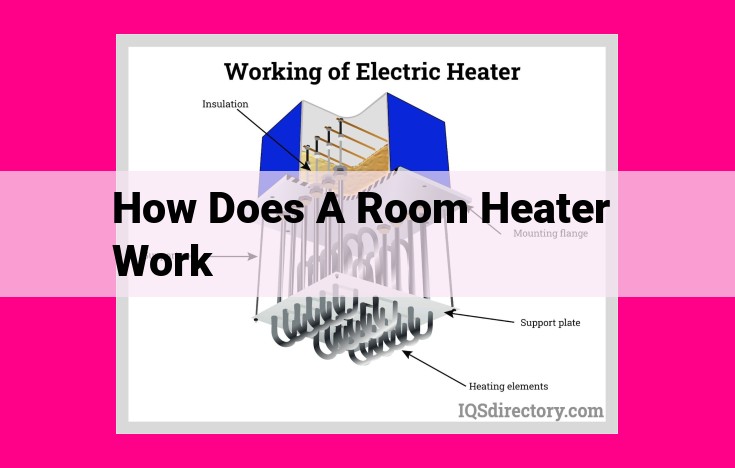Electric Room Heaters: Warmth, Efficiency, And Safety For Your Home

Electric room heaters work by converting electrical energy into heat. Electricity flows through a heating element, generating heat that is then dispersed into the room. The thermostat maintains the desired temperature by automatically turning the heater on and off. Safety features like overheat protection and tip-over switches prevent accidents. Radiant heaters provide instant warmth, while convection heaters distribute heat throughout the room. Combination heaters offer both benefits. Oil-filled radiators gradually release stored heat. Energy Star certification and programmable thermostats maximize energy efficiency.
Understanding the Basics of Electric Heaters
Imagine yourself on a cold winter night, your home feeling like a chilly void. You reach for an electric heater, a beacon of warmth in the icy darkness. But before you plug it in, let’s delve into the inner workings of this cozy companion.
Just like any electrical device, electric heaters rely on the flow of electricity through their circuits. Current and voltage work together to produce power, the driving force behind the heat generation. The heating element, usually made of metal, converts this electrical energy into heat.
To ensure your heater operates safely and efficiently, it’s equipped with a thermostat and temperature sensor. These components monitor the room temperature and adjust the heating element’s activity accordingly. A control knob allows you to set your desired temperature.
Safety is paramount with electric heaters, so they come with built-in overheat protection to prevent overheating. A tip-over switch automatically shuts off the heater if it’s accidentally knocked over. Some models also feature a GFCI (Ground Fault Circuit Interrupter) to protect against electrical shocks.
The housing material of an electric heater can vary, from plastic to metal. Choose a material that complements your home décor and provides durability.
Types of Electric Heaters: A Journey Through Heating Solutions
When the chill sets in and you crave cozy warmth, electric heaters emerge as reliable companions. But with so many types available, navigating the options can be daunting. Let’s embark on a storytelling journey to unravel the unique characteristics of each type.
Radiant Heaters: Instant, Directional Sunshine
Imagine the comforting glow of a campfire on a crisp evening. Radiant heaters mimic this experience, emitting infrared waves that directly warm objects in their path. No need to wait for heated air to circulate; you’ll feel the warmth the moment you turn them on. Perfect for spot heating or chilly balconies.
Convection Heaters: Gentle, Room-Wide Embers
Like a gentle breeze carrying warmth, convection heaters draw in cool air, heat it using a heating element, and release it into the room. They gradually raise the overall temperature, creating a comfortable ambiance throughout. Their fan-driven circulation ensures even distribution of heat.
Combination Heaters: A Balanced Blend of Warmth
Combination heaters offer the best of both worlds. They combine radiant and convection heating to provide immediate warmth and maintain a cozy atmosphere. Imagine curling up in front of a fireplace while the room itself gradually fills with warmth.
Electric Fireplaces: Ambiance and Supplemental Comfort
Electric fireplaces evoke the charm of a traditional hearth without the hassle of real flames. They provide a mesmerizing focal point, casting a warm glow and adding cozy ambiance to any room. While they primarily serve as supplemental heat sources, they can also take the chill off on mild evenings.
Oil-Filled Radiators: Gradual, Long-Lasting Warmth
Think of oil-filled radiators as thermal batteries. They heat oil within their sealed chambers, which then gradually release warmth over many hours. Perfect for bedrooms and spaces where consistent, low-maintenance heating is desired. Their compact size makes them easy to tuck into corners or under desks.
Choosing the Right Electric Heater
Like finding the perfect winter coat, choosing the right electric heater depends on your specific needs and preferences. Consider the size of the space, the desired level of warmth, and the features that are important to you. Whether you seek instant coziness, whole-room comfort, or a touch of ambiance, there’s an electric heater to suit your needs.
Energy Efficiency and Safety Considerations
When choosing an electric heater, it’s crucial to prioritize energy efficiency and safety features. These factors will not only minimize your energy consumption and expenses but also ensure a safe and comfortable heating experience.
Energy Star Certification
Look for electric heaters that have earned the Energy Star certification. This certification verifies that the heater meets specific energy efficiency standards. Energy Star heaters consume less energy while still maintaining effective heating performance. By reducing your energy consumption, you can save money on your electricity bills while being environmentally responsible.
Low Wattage
The wattage of a heater determines how much energy it consumes. Lower wattage heaters use less energy. Choose a heater with a wattage appropriate for the size of the room you want to heat. A higher wattage heater may be necessary for larger spaces, but for smaller areas, a low-wattage heater will be sufficient and more energy-efficient.
Programmable Thermostat
A programmable thermostat allows you to set the desired temperature and schedule when the heater turns on and off. This feature is especially useful for saving energy. By programming the thermostat to maintain a lower temperature during the night or when you’re away, you can prevent unnecessary heating and reduce your energy consumption.